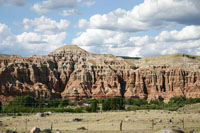2.24: Paleogene Period (66 to 23 million years ago)
- Page ID
- 9793
\( \newcommand{\vecs}[1]{\overset { \scriptstyle \rightharpoonup} {\mathbf{#1}} } \) \( \newcommand{\vecd}[1]{\overset{-\!-\!\rightharpoonup}{\vphantom{a}\smash {#1}}} \)\(\newcommand{\id}{\mathrm{id}}\) \( \newcommand{\Span}{\mathrm{span}}\) \( \newcommand{\kernel}{\mathrm{null}\,}\) \( \newcommand{\range}{\mathrm{range}\,}\) \( \newcommand{\RealPart}{\mathrm{Re}}\) \( \newcommand{\ImaginaryPart}{\mathrm{Im}}\) \( \newcommand{\Argument}{\mathrm{Arg}}\) \( \newcommand{\norm}[1]{\| #1 \|}\) \( \newcommand{\inner}[2]{\langle #1, #2 \rangle}\) \( \newcommand{\Span}{\mathrm{span}}\) \(\newcommand{\id}{\mathrm{id}}\) \( \newcommand{\Span}{\mathrm{span}}\) \( \newcommand{\kernel}{\mathrm{null}\,}\) \( \newcommand{\range}{\mathrm{range}\,}\) \( \newcommand{\RealPart}{\mathrm{Re}}\) \( \newcommand{\ImaginaryPart}{\mathrm{Im}}\) \( \newcommand{\Argument}{\mathrm{Arg}}\) \( \newcommand{\norm}[1]{\| #1 \|}\) \( \newcommand{\inner}[2]{\langle #1, #2 \rangle}\) \( \newcommand{\Span}{\mathrm{span}}\)\(\newcommand{\AA}{\unicode[.8,0]{x212B}}\)
Paleogene Period (66 to 23 million years ago)
|
Period |
Epoch |
Notes |
Time Range |
| Paleogene |
Paleocene Epoch |
The mass extinction at the end of the Cretaceous Period left many of the niches filled by dinosaurs and large swimming reptiles empty. Mammals with placental-type live birth appear. Shallow seas of the Cretaceous period withdrew or were gradually replaced by lakes. In North America, the Rocky Mountains began to rise. See more about the Paleocene: American Museum of Natural History | 66 to 56 million |
|
Eocene Epoch |
Modern-like forms of mammals appear and diversify in the fossil record during the Eocene Epoch. The Eocene was a warm period with an expanded tropical realm. The end of the Eocene period is marked by a mass extinction that may have involved asteroid collisions in Siberia and in the vicinity of Chesapeake Bay. See more about the Eocene: American Museum of Natural History | 56 to 33.9 million | |
|
Oligocene Epoch |
The Oligocene was a time of transition when older life forms were replace with life forms that dominate the world today. The warmer, more tropical environments of the Eocene Epoch gave way to dryer landscapes dominated by grasslands, whereas broad-leaf forests became more restricted to the equatorial realm. See more about the Oligocene: American Museum of Natural History | 33.9 to 23.0 million |






